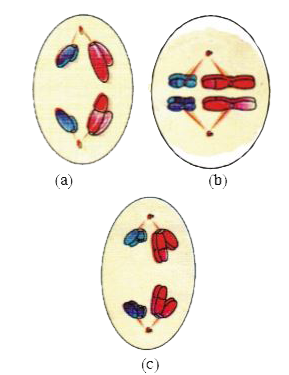What are homologous chromosomes? Contrast the genetic makeup of sister chromatids with nonsister chromatids.
Step-by-Step Text Solution
Step 1: Definition of Homologous Chromosomes
Homologous chromosomes are pairs of chromosomes in a diploid organism, where one chromosome is inherited from the mother and the other from the father. These chromosomes are similar in size, shape, and genetic content, meaning they carry the same genes at the same loci, but may have different alleles (variations of a gene).
Step 2: Characteristics of Homologous Chromosomes
- Length and Shape: Homologous chromosomes are similar in length and have the same centromere position.
- Gene Composition: They contain the same genes, but the alleles for those genes can differ. For example, one chromosome may carry an allele for brown eyes while the homologous chromosome may carry an allele for blue eyes.
Step 3: Sister Chromatids
Sister chromatids are identical copies of a single chromosome that are formed during DNA replication. After replication, each chromosome consists of two sister chromatids that are joined together at a region called the centromere. They have the same genetic makeup because they are exact copies of each other.
Step 4: Non-Sister Chromatids
Non-sister chromatids refer to chromatids from different homologous chromosomes. For example, one chromatid from the maternal chromosome and one from the paternal chromosome. These chromatids may carry different alleles for the same genes, contributing to genetic diversity.
Step 5: Contrast Between Sister and Non-Sister Chromatids
- Genetic Makeup: Sister chromatids are genetically identical, whereas non-sister chromatids can have different alleles for the same genes.
- Origin: Sister chromatids originate from the same chromosome after DNA replication, while non-sister chromatids come from different homologous chromosomes.
Homologous chromosomes are pairs of chromosomes in a diploid organism, where one chromosome is inherited from the mother and the other from the father. These chromosomes are similar in size, shape, and genetic content, meaning they carry the same genes at the same loci, but may have different alleles (variations of a gene).
- Length and Shape: Homologous chromosomes are similar in length and have the same centromere position.
- Gene Composition: They contain the same genes, but the alleles for those genes can differ. For example, one chromosome may carry an allele for brown eyes while the homologous chromosome may carry an allele for blue eyes.
Sister chromatids are identical copies of a single chromosome that are formed during DNA replication. After replication, each chromosome consists of two sister chromatids that are joined together at a region called the centromere. They have the same genetic makeup because they are exact copies of each other.
Non-sister chromatids refer to chromatids from different homologous chromosomes. For example, one chromatid from the maternal chromosome and one from the paternal chromosome. These chromatids may carry different alleles for the same genes, contributing to genetic diversity.
- Genetic Makeup: Sister chromatids are genetically identical, whereas non-sister chromatids can have different alleles for the same genes.
- Origin: Sister chromatids originate from the same chromosome after DNA replication, while non-sister chromatids come from different homologous chromosomes.
Topper's Solved these Questions
- CELL CYCLE AND CELL DIVISION BOOK - ICSECHAPTER - CELL CYCLE AND CELL DIVISION EXERCISE - TEST YOUR PROGRESS (HIGHER ORDER THINKING SKILLS QUESTIONS (HOTS))
8 Videos
- CELL CYCLE AND CELL DIVISION BOOK - ICSECHAPTER - CELL CYCLE AND CELL DIVISION EXERCISE - NCERT EXERCISE WITH ANSWER
22 Videos
- CELL CYCLE AND CELL DIVISION BOOK - ICSECHAPTER - CELL CYCLE AND CELL DIVISION EXERCISE - TEST YOUR PROGRESS (VERY SHORT ANSWER TYPE QUESTION)
30 Videos
- CELL : THE UNIT OF LIFE BOOK - ICSECHAPTER - CELL : THE UNIT OF LIFE EXERCISE - Differentiate Between
18 Videos
- CELLULAR RESPIRATION IN PLANTS BOOK - ICSECHAPTER - CELLULAR RESPIRATION IN PLANTS EXERCISE - REVIEW QUESTIONS ( LONG ANSWER TYPE QUESTIONS)
15 Videos
Similar Questions
Sister chromatids are found in
View SolutionSister chromatids are joined at
View SolutionIdentify the meiotic stage in which the homologous chromosomes separate while the sister chromatids remain associated at their centrometres. Or In which stage of meiosis homologous chromosomes are segregated
View SolutionThe homologous chromosomes separate, while sister chromatids remain associated at their centromeres during
View SolutionSister chromatids of a chromosome have :
View SolutionParental chromosome produce two identical sister chromatids during
View Solution
Match the above figures (a, b, c) with their events given below :-
(I) Nucleolus disappear
(II) Formation of tetrad of cell
(III) Homologous chromosomes separate
(IV) Microtubules attached to the kinetochore of sister chromatids
(V) Separation of sister chromatids
(VI) Bivalent chromosomes align on theequatorial plate
View SolutionFailure of separation of sister chromatids us
View SolutionA : Anaphase-I is actual phase of reduction in number of chromosomes.
R : Homologous chromosomes move to the opposite poles with both their chromatids.
View SolutionThe figure given below represents the stage of cell division. Read the following statements.

(i) Nucleolus, Golgi complex and ER reform.
(ii) Chromatids move to the opposite pole.
(iii) The activity of the recombinase enzyme.
(iv) Homologous chromosomes separate while sister chromatids associated at their centromere.
(v ) Initiation of the assembly of the mitotic spindle.
How many of the above statements is not true with respect to the above figure
View Solution
